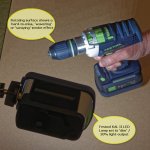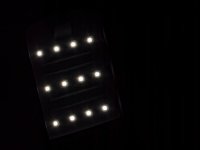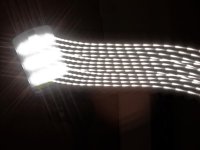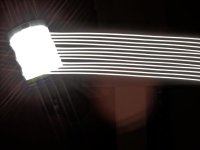KolinP
Member
- Joined
- Sep 9, 2015
- Messages
- 33
This very long post is about how the LEDs in the SysLite KAL II are dimmed by the lamp's electronics when we switch its light-output to the lower (dimmer) 30% intensity.
(Thank you to the moderator who fixed the positions of my photos.)
First, a background note:
A few days ago, in a post about the much bigger Syslite Duo (Syslite Duo with Tripod) I replied to a comment by [member=41196]Nat X[/member] when he (correctly) pointed out that LEDs are dimmed by being
In my response to Nat I suggested that - for Health & Safety reasons (see next paragraph) - this method of dimming LEDs might not be true for lights that are sold as "work lights". I suggested instead that to avoid stroboscopic effects caused by LED flicker, the power that's fed to the Syslite LEDs would probably be kept at a steady, non-oscillating, DC voltage level, and that the internal voltage would simply be reduced by a certain amount to 'dim' the LEDs. But, with a couple of quick experiments I discovered that the KAL II Syslite's LEDs are indeed dimmed electronically by being oscillated on and off very rapidly!
The reason why I felt sure that rapid oscillation would NOT be used to dim the LEDs was because of the hazards (well known and accepted) of stroboscopic effects that can be seen with rotating machinery when a workspace is lit by lights powered by the 50Hz or 60Hz AC current in our 'line' or 'mains' electricity supplies. These 50Hz/60Hz strobe effects are usually minimised with careful lighting installations, which probably explains why the subject isn't talked about much outside of Health & Safety Inspector's visits to our workshops. However, it is also possible to get similar, even stronger stroboscopic effects if workspace lighting is used which flickers or oscillates at frequencies higher than 50Hz/60Hz ... such as that delivered by some types of portable lights ...
... so, at the risk of inviting the Health & Safety bogey-man into the room, I decided to test my KAL II Syslite to find out how its LEDs are really dimmed.
The results of my very non-scientific tests suggest that the Festool designers found a wonderfully clever way to compensate for the actual stroboscopic effect that I saw when I illuminated the spinning chuck of my PDC 18/4 drill with my Syslite KAL II set to its 'dim', 30% intensity light-level, as in this photo ...
[attachimg=1]
What I saw was that the strobe effect on the spinning chuck was 'wavering' and varying in its illusory 'rotation'. In other words, even with the drill speed held at a steady RPM (I chose a speed near maximum in the PDC drill's second gear), the stroboscopic 'ghost' of the spinning chuck never stayed still. The ghost image of the chuck's indented surface was always moving. It meandered continuously to-and-fro, with the result that (in my humble opinion based on these tests) the unavoidable stroboscopic effect of the KAL II's oscillating LEDs became a non-problem!
Please try this yourself if you've got a Syslite KAL II and a drill, or any other rotating surface. Shine your KAL II light, set to 30% output-intensity, towards the spinning tool - perhaps with the room lights turned down - and find a speed which causes the strobe-effect to appear ... then hold your tool's speed steady. I predict that, provided your KAL II is the same model and design as my KAL II, you will see a never-stationary, wavering stroboscopic effect similar to what I saw.
Regarding the 'Full', 100% intensity LED output of the KAL II; in my tests I could see no evidence at all of any strobing at any speed when the light was set to its Full power setting. Therefore I deduce that at 100% LED intensity, the KAL II LEDs do not oscillate or flicker. This is just my deduction of course.
Important disclaimers:
[list type=decimal]
[*]I own a SysLite KAL II. I do not own a SysLite Duo. I do not have any special knowledge about Syslite designs.
[*]My tests here were done ONLY with a Syslite KAL II.
[*]I have read the two PDFs offered by Festool for this KAL II lamp:
(A.) the Festool (generic hand-tool) Safety instructions and
(B.) the Syslite KAL II specific Safety instructions which are printed among pages 11 to 16 (in the English language section) of the light's Operating Manual. (I downloaded both of those PDF's (A.) and (B.) two days ago from the Festool (UK) Syslite KAL II web-page.)
[*]On Page 12 of that Operating Manual, Festool warns us (I quote) "Do not use the working light for road lighting applications. The working light is not approved for illuminating the road.(end of quote)
[*]There is no mention in those two PDFs about stroboscopic hazards with rotating machinery. However, if my deductions are correct about this clever meandering stroboscopic effect that I saw in my tests then I can easily understand why there was no need to mention them!
[*]This KAL II lamp and the much more powerful SysLite Duo are (in my un-informed opinion) NOT likely to use the same or even similar electronics to drive their LEDs. In particular, the SysLite Duo does not have a "low light level" setting like the KAL II's.
[*]The SysLite Duo does have a self-protection scheme which will (somehow) dim the LEDs if the overall temperature of the unit gets too high.
[*]I do not know how Festool's designers achieve this protective LED 'dimming' in the SysLite Duo, and I do not know whether that SysLite Duo dimming is achieved by the same mechanism that appears to be used here in my non-scientific review of my KAL II's 'dim' LED behaviour.
[*]Please do not draw any parallels between the LED outputs of these two very different lamp designs. Do your own tests and experiments if you wish.
[/list]
Finally ... I will try as briefly as I can to explain the first two tests that I did on my KAL II, using a camera, before I thought of doing the far easier test that I describe above with the spinning drill chuck.
Step 1. Support your KAL II light with its LED array lined up like this:
[attachimg=2]
Step 2. Set your camera to manual exposure with a very small aperture to reduce the obvious glare as much as possible. (With my camera I was able to use an aperture equivalent to F/32) - And set an exposure duration of about 1.5 seconds. (You may need to experiment a bit, and this type of shot might not be possible with a smart-phone camera(?))
Step 3. Point your camera at your KAL II, then press the shutter and pause briefly (long enough to say "one banana ..."), then do Step 4.
Step 4. Rotate your whole body and the camera, sideways, away from the KAL II, as fast as you can. (A tip: in order to reduce background clutter in your photo while the camera gets to the end of its 1.5 second exposure, bring your camera to rest pointing at a blank wall or a non-patterned floor.)
Step 5. Peek at your camera's preview screen and see if you've got something like this:
[attachimg=3]
Now, if put my non-scientific speculator's hat on again, this LED light trail suggests that each row of four LEDs is flickering (oscillating) at a different frequency! The top row of LEDs in my picture is oscillating a little more rapidly than the middle row of LEDs (etc.) which explains (I speculate) why the light-trail dots do not line up vertically. (No, I don't think the different dot-spacing is caused by me curving the camera downwards as I rotated my body away from the KAL II.)
Anyway, I reckon that this clever scheme of oscillating the LEDs at different rates is (in general) what produces the intriguing, meandering or swaying strobe effect when (or if) this lamp is used to illuminate rotating parts.
(Assuming I'm not proved wrong, and assuming my deductions are generally correct) I offer a respectful and admiring salute to the Festool designers for this clever feature in the KAL II [thanks]
Finally finally ... here's what I saw when I repeated the same camera experiment with my KAL II switched to Full 100% output power:
[attachimg=4]
From the absence of any visible dots in this second set of light trails, I will conclude that - as I did above with my rotating drill chuck - the LEDs in the KAL II do not oscillate or flicker when it is switched to 100% light output.
I welcome any critiques or refutations, or better still, perhaps a confirmation or two from other Syslite KAL II owning FOG members [big grin]
Colin P.
(Thank you to the moderator who fixed the positions of my photos.)
First, a background note:
A few days ago, in a post about the much bigger Syslite Duo (Syslite Duo with Tripod) I replied to a comment by [member=41196]Nat X[/member] when he (correctly) pointed out that LEDs are dimmed by being
"oscillated on and off at a speed which is hopefully too fast for your eyes to detect"
In my response to Nat I suggested that - for Health & Safety reasons (see next paragraph) - this method of dimming LEDs might not be true for lights that are sold as "work lights". I suggested instead that to avoid stroboscopic effects caused by LED flicker, the power that's fed to the Syslite LEDs would probably be kept at a steady, non-oscillating, DC voltage level, and that the internal voltage would simply be reduced by a certain amount to 'dim' the LEDs. But, with a couple of quick experiments I discovered that the KAL II Syslite's LEDs are indeed dimmed electronically by being oscillated on and off very rapidly!
The reason why I felt sure that rapid oscillation would NOT be used to dim the LEDs was because of the hazards (well known and accepted) of stroboscopic effects that can be seen with rotating machinery when a workspace is lit by lights powered by the 50Hz or 60Hz AC current in our 'line' or 'mains' electricity supplies. These 50Hz/60Hz strobe effects are usually minimised with careful lighting installations, which probably explains why the subject isn't talked about much outside of Health & Safety Inspector's visits to our workshops. However, it is also possible to get similar, even stronger stroboscopic effects if workspace lighting is used which flickers or oscillates at frequencies higher than 50Hz/60Hz ... such as that delivered by some types of portable lights ...
... so, at the risk of inviting the Health & Safety bogey-man into the room, I decided to test my KAL II Syslite to find out how its LEDs are really dimmed.
The results of my very non-scientific tests suggest that the Festool designers found a wonderfully clever way to compensate for the actual stroboscopic effect that I saw when I illuminated the spinning chuck of my PDC 18/4 drill with my Syslite KAL II set to its 'dim', 30% intensity light-level, as in this photo ...
[attachimg=1]
What I saw was that the strobe effect on the spinning chuck was 'wavering' and varying in its illusory 'rotation'. In other words, even with the drill speed held at a steady RPM (I chose a speed near maximum in the PDC drill's second gear), the stroboscopic 'ghost' of the spinning chuck never stayed still. The ghost image of the chuck's indented surface was always moving. It meandered continuously to-and-fro, with the result that (in my humble opinion based on these tests) the unavoidable stroboscopic effect of the KAL II's oscillating LEDs became a non-problem!
Please try this yourself if you've got a Syslite KAL II and a drill, or any other rotating surface. Shine your KAL II light, set to 30% output-intensity, towards the spinning tool - perhaps with the room lights turned down - and find a speed which causes the strobe-effect to appear ... then hold your tool's speed steady. I predict that, provided your KAL II is the same model and design as my KAL II, you will see a never-stationary, wavering stroboscopic effect similar to what I saw.
Regarding the 'Full', 100% intensity LED output of the KAL II; in my tests I could see no evidence at all of any strobing at any speed when the light was set to its Full power setting. Therefore I deduce that at 100% LED intensity, the KAL II LEDs do not oscillate or flicker. This is just my deduction of course.
Important disclaimers:
[list type=decimal]
[*]I own a SysLite KAL II. I do not own a SysLite Duo. I do not have any special knowledge about Syslite designs.
[*]My tests here were done ONLY with a Syslite KAL II.
[*]I have read the two PDFs offered by Festool for this KAL II lamp:
(A.) the Festool (generic hand-tool) Safety instructions and
(B.) the Syslite KAL II specific Safety instructions which are printed among pages 11 to 16 (in the English language section) of the light's Operating Manual. (I downloaded both of those PDF's (A.) and (B.) two days ago from the Festool (UK) Syslite KAL II web-page.)
[*]On Page 12 of that Operating Manual, Festool warns us (I quote) "Do not use the working light for road lighting applications. The working light is not approved for illuminating the road.(end of quote)
[*]There is no mention in those two PDFs about stroboscopic hazards with rotating machinery. However, if my deductions are correct about this clever meandering stroboscopic effect that I saw in my tests then I can easily understand why there was no need to mention them!
[*]This KAL II lamp and the much more powerful SysLite Duo are (in my un-informed opinion) NOT likely to use the same or even similar electronics to drive their LEDs. In particular, the SysLite Duo does not have a "low light level" setting like the KAL II's.
[*]The SysLite Duo does have a self-protection scheme which will (somehow) dim the LEDs if the overall temperature of the unit gets too high.
[*]I do not know how Festool's designers achieve this protective LED 'dimming' in the SysLite Duo, and I do not know whether that SysLite Duo dimming is achieved by the same mechanism that appears to be used here in my non-scientific review of my KAL II's 'dim' LED behaviour.
[*]Please do not draw any parallels between the LED outputs of these two very different lamp designs. Do your own tests and experiments if you wish.
[/list]
Finally ... I will try as briefly as I can to explain the first two tests that I did on my KAL II, using a camera, before I thought of doing the far easier test that I describe above with the spinning drill chuck.
Step 1. Support your KAL II light with its LED array lined up like this:
[attachimg=2]
Step 2. Set your camera to manual exposure with a very small aperture to reduce the obvious glare as much as possible. (With my camera I was able to use an aperture equivalent to F/32) - And set an exposure duration of about 1.5 seconds. (You may need to experiment a bit, and this type of shot might not be possible with a smart-phone camera(?))
Step 3. Point your camera at your KAL II, then press the shutter and pause briefly (long enough to say "one banana ..."), then do Step 4.
Step 4. Rotate your whole body and the camera, sideways, away from the KAL II, as fast as you can. (A tip: in order to reduce background clutter in your photo while the camera gets to the end of its 1.5 second exposure, bring your camera to rest pointing at a blank wall or a non-patterned floor.)
Step 5. Peek at your camera's preview screen and see if you've got something like this:
[attachimg=3]
Now, if put my non-scientific speculator's hat on again, this LED light trail suggests that each row of four LEDs is flickering (oscillating) at a different frequency! The top row of LEDs in my picture is oscillating a little more rapidly than the middle row of LEDs (etc.) which explains (I speculate) why the light-trail dots do not line up vertically. (No, I don't think the different dot-spacing is caused by me curving the camera downwards as I rotated my body away from the KAL II.)
Anyway, I reckon that this clever scheme of oscillating the LEDs at different rates is (in general) what produces the intriguing, meandering or swaying strobe effect when (or if) this lamp is used to illuminate rotating parts.
(Assuming I'm not proved wrong, and assuming my deductions are generally correct) I offer a respectful and admiring salute to the Festool designers for this clever feature in the KAL II [thanks]
Finally finally ... here's what I saw when I repeated the same camera experiment with my KAL II switched to Full 100% output power:
[attachimg=4]
From the absence of any visible dots in this second set of light trails, I will conclude that - as I did above with my rotating drill chuck - the LEDs in the KAL II do not oscillate or flicker when it is switched to 100% light output.
I welcome any critiques or refutations, or better still, perhaps a confirmation or two from other Syslite KAL II owning FOG members [big grin]
Colin P.




